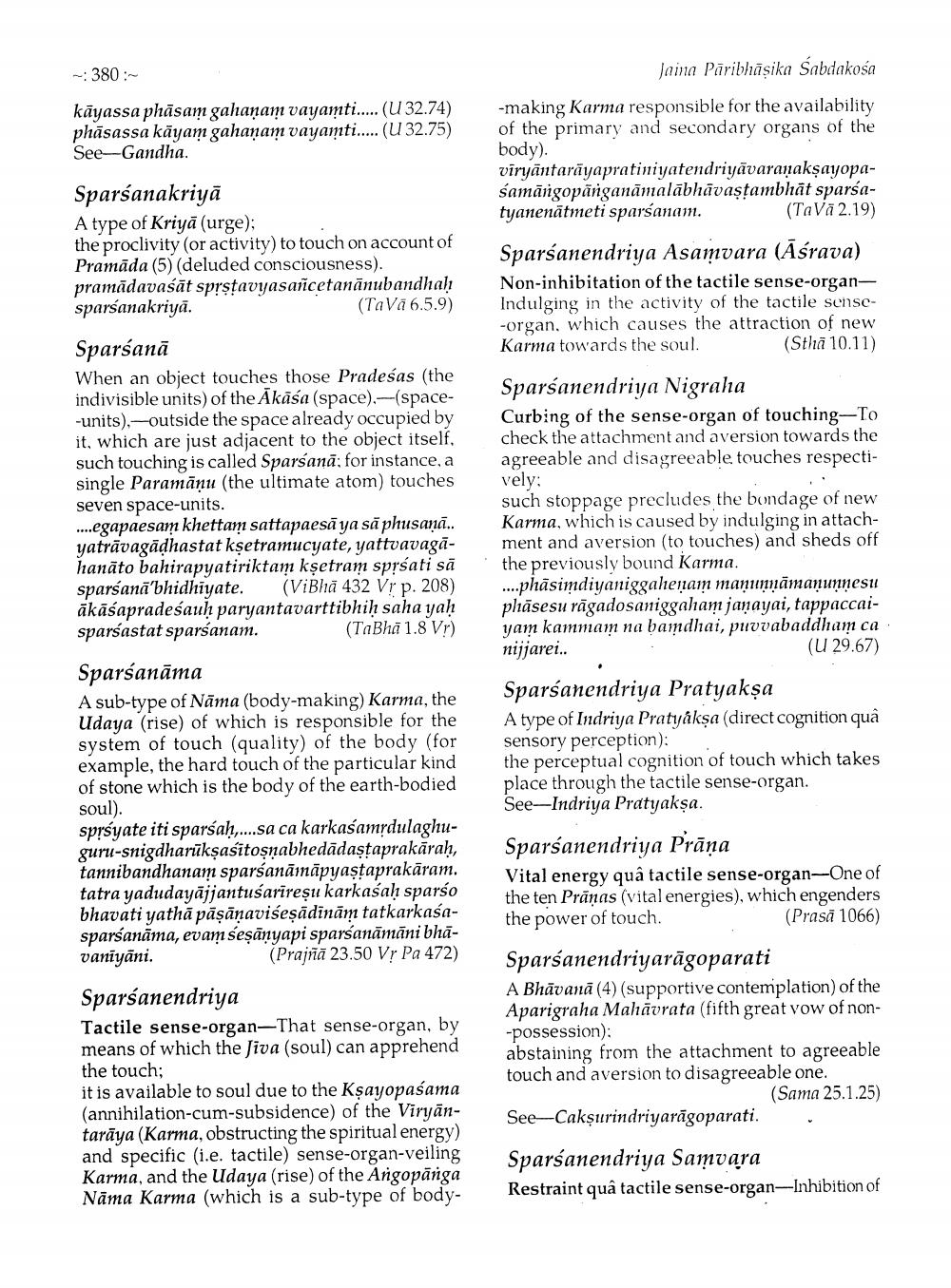________________
- 380:
kāyassa phāsam gahanam vayamti..... (U 32.74) phāsassa kāyam gahanam vayamti..... (U 32.75) See-Gandha.
Jaina Pāribhāsika Sabdakosa -making Karma responsible for the availability of the primary and secondary organs of the body). viryäntarāyapratiniyatendriyavaranakşayopasamārgopānganāmalābhāvastambhāt sparsatyanenātmeti sparsanam.
(Tavā 2.19)
Sparśanakriya A type of Kriyā (urge); the proclivity (or activity) to touch on account of Pramāda (5) (deluded consciousness). pramādavaśāt sprstavyasañcetanānubandhah sparśanakriya.
(Tavā 6.5.9)
Sparśanendriya Asamvara (Aśrava) Non-inhibitation of the tactile sense-organIndulging in the activity of the tactile sense-organ, which causes the attraction of new Karma towards the soul.
(Stha 10.11)
Sparśanā When an object touches those Pradeśas (the indivisible units) of the Akāśa (space).-(space-units),-outside the space already occupied by it, which are just adjacent to the object itself, such touching is called Sparsanā; for instance, a single Paramānu (the ultimate atom) touches seven space-units. ....egapaesam khettam sattapaesā ya sāphusaņā.. yatrāvagādhastat kşetramuchate, yattvavagahanāto bahirapyatiriktam kşetram sprśati sā sparsanā'bhidhīyate. (ViBhā 432 Vr p. 208) ākāśapradeśauh paryantavarttibhiḥ saha yaḥ sparsastat sparsanam.
(TaBhā 1.8 Vr)
Sparśanendriya Nigraha Curbing of the sense-organ of touching-To check the attachment and aversion towards the agreeable and disagreeable touches respectively: such stoppage precludes the bondage of new Karma, which is caused by indulging in attachment and aversion (to touches) and sheds off the previously bound Karma. ....phāsimdiyaniggahenain manunnāmanunnesu phāsesu rāgadosaniggaham janayai, tappaccaiyam kammam na bamdhai, puvvabaddham ca nijjarei..
(U 29.67)
Sparśanāma A sub-type of Nāma (body-making) Karma, the Udaya (rise) of which is responsible for the system of touch (quality) of the body (for example, the hard touch of the particular kind of stone which is the body of the earth-bodied soul). sprśyate iti sparśaḥ,....sa ca karkasamrdulaghuguru-snigdharūkşasītosnabhedādaştaprakāraḥ, tannibandhanam sparsanāmāpyaştaprakāram. tatra yadudayājjantuśarīreşu karkasaḥ sparso bhavati yathā pāşāņaviseşādinām tatkarkasasparsanāma, evam seşānyapi sparsanāmāni bhāvanīyāni.
(Prajmã 23.50 Vr Pa 472)
Sparśanendriya Pratyakșa A type of Indriya Pratyákṣa (direct cognition quâ sensory perception): the perceptual cognition of touch which takes place through the tactile sense-organ. See—Indriya Pratyakşa.
Sparśanendriya Prāna Vital energy quâ tactile sense-organ--One of the ten Prāņas (vital energies), which engenders the power of touch.
(Prasä 1066)
Sparśanendriya Tactile sense-organ-That sense-organ, by means of which the Jiva (soul) can apprehend the touch; it is available to soul due to the Kşayopasama (annihilation-cum-subsidence) of the Viryantarāya (Karma, obstructing the spiritual energy) and specific (i.e. tactile) sense-organ-veiling Karma, and the Udaya (rise) of the Angopānga Nāma Karma (which is a sub-type of body
Sparśanendriyarāgoparati A Bhāvanā (4) (supportive contemplation) of the Aparigraha Mahāvrata (fifth great vow of non-possession); abstaining from the attachment to agreeable touch and aversion to disagreeable one.
(Sama 25.1.25) See--Cakşıırindriyarāgoparati.
Sparsanendriya Samvara Restraint quâ tactile sense-organ-Inhibition of




